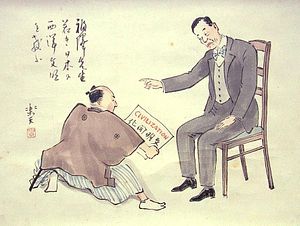For Japan, 2018 marks the 150th anniversary of the Meiji Restoration; the name given to the events of 1868, which saw the downfall of the Tokugawa shogunate (or bakufu) and the creation of a new government with a central focus on imperial rule under the Emperor Meiji. The Restoration is one of the two great divides of modern Japanese history, the other being Japan’s defeat by the allied powers in August 1945.
There are varying viewpoints regarding the character of the Meiji Restoration. While in some ways it can be regarded as a revolution, it wasn’t the case that the shogun Tokugawa was killed, in the way that the imperial family was killed during the French Revolution. Edo Castle – where the shogun resided – was surrendered and handed over without bloodshed, and although the Meiji Restoration marked the end of shogunate rule by the Tokugawa dynasty, it was members of the same samurai class as the shoguns themselves who ended it – albeit members of samurai clans from outlying areas such as the Satsuma and Choshu domains (which correspond to the modern day prefectures of Kagoshima and Yamaguchi).
It was also not the case that the lords of those feudal domains who drove the Tokugawa shogunate to its demise then took over as the subsequent rulers in place of the Tokugawa clan. The ultimate outcome of the Meiji Restoration was that the emperor was restored as Japan’s supreme ruler, and that samurai from the Satsuma and Choshu domains – and eventually those of lower rank from other parts of the country – became the key players in the new government.
In that sense, the Meiji Restoration was an internal power struggle between samurai of the same class, and the result of conflicts between samurai of outlying areas against the centrally based ruling samurai of Edo, and between samurai of higher and lower ranks.
Although it may not have been a revolution in the sense that it was an internal struggle between members of the same warrior class, the Meiji Restoration did have some revolutionary elements, in the sense that it was a struggle between samurai in central and outlying areas, and between persons of higher and lower rank.
Viewed in international terms, another result of the Meiji Restoration was that Japan adapted to the times, in terms of becoming a modern nation. The Meiji government regarded Japan as a sovereign state, taking direct control over the entire country and working to revise unequal treaties, increase national wealth and military strength, and encourage the growth and development of new industry. Naturally, the character of this new modern nation also included going on to seek resources and markets from the outside world. For this reason, some historians argue that the Meiji Restoration was the original starting point that eventually led to the Japanese invasion and occupation of surrounding Asian countries; although in Japan we do not seek to place original blame on the Meiji Restoration for these actions, but regard them rather as the result of subsequent Japanese politics and diplomacy.
In East Asia, the Meiji Restoration is held in comparatively high regard. It is said that Taiwan’s Chiang Kai-shek and leaders of other surrounding countries commended it as an example of strongly spontaneous reform and innovation, as an adaptation to the global historical situation. Admiration for bushido (the Japanese “way of the warrior”), which enables personal transformation, could also surely be included in this description.
However, when viewed from the perspective of the same period, at least up until 1880, the Restoration was not viewed positively by Japan’s neighbors. During the 1870s there were a stream of civil conflicts and insurgencies by fuhei shizoku (discontented former samurai), and the new government found money tight as it struggled to deal with them. It was only with the fiscal austerity measures instituted by Finance Minister Matsutaka Masayoshi during the 1880s that Japan was eventually able to achieve and maintain a healthy fiscal situation. I would argue that the key reason why the Meiji Restoration is regarded positively by surrounding nations is that Japan emerged victoriously from both the Sino-Japanese and Russo-Japanese Wars that followed.
In the past, when only America, the European states and Japan were developed nations, the Meiji Restoration was regarded as the starting point for Japan’s success. History has since been told from the perspective of why Japan was able to adapt to the times and emerge as a modern nation during the mid-nineteenth century, and why other Asian nations were not able to quite replicate the feat.
Today, however, China is making tremendous advances, becoming the world’s second largest economy, and many other countries are also enjoying greater wealth and affluence. For this reason, it no longer can necessarily be concluded that the fact that Japan was able to achieve the Meiji Restoration during the mid-nineteenth century is a true success story, and nor can the comparatively gradual handling of national adaptation exhibited by the Chinese Qing dynasty during that period be viewed as necessarily a failure.
In the 21st century, Japan is agonizing over how it should set its national targets. It seems unlikely that Japan can adapt to this new age simply with the mindset of catching up to – and surpassing – Western countries, or by becoming the leading country in Asia.
Having now marked the 150th anniversary of the Meiji Restoration, Japan now must face the issue of how it will move on from that national identity that it created for itself starting those heady days a century and a half ago.
Shin Kawashima is a professor at the University of Tokyo.

































